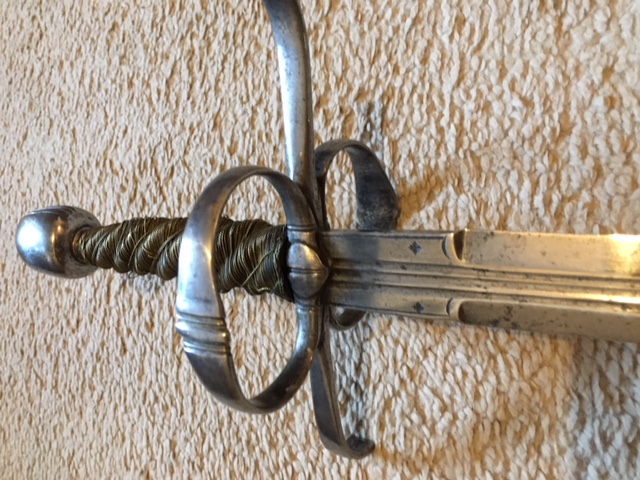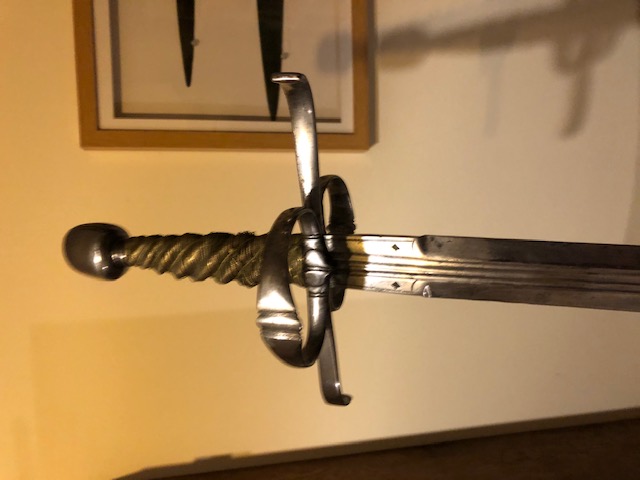I am new here, this is my first post.
I have been reading Joachim Meyer's books and it got me wondering what actual longswords looked like in his time (1550-1600)? What would set longswords of this period apart from other longswords?
| Nathan Robinson wrote: |
| Have a look at this Spotlight Topic
http://myArmoury.com/talk/viewtopic.php?t=19720 |
Thank you, that is exactly what I was looking for.
Hi Joe and welcome
This is one I have. Probably early part of the 16th century, around 1520ish maybe. Probably Italian but uncertain. Typical ring hilt of the 16th century.
The post topic Nathan linked to you is excellent.
 Attachment: 159.49 KB
Attachment: 159.49 KB

 Attachment: 47.96 KB
Attachment: 47.96 KB

 Attachment: 485.25 KB
Attachment: 485.25 KB

This is one I have. Probably early part of the 16th century, around 1520ish maybe. Probably Italian but uncertain. Typical ring hilt of the 16th century.
The post topic Nathan linked to you is excellent.



| Daniel Parry wrote: |
| Typical ring hilt of the 16th century. |
I hate the term ring hilt describing anything but Migration era ring-hilted swords. The fact that these compound-hilted or complex-hilted swords have various guards or "rings" does not make these "ring hilts." Calling them that muddies the waters of definition and is confusing because it does not describe the sword or differentiate it from the many varieties of such swords.
I would call your sword a 16th century longsword and describe it as having a compound hilt with a forward and a rear side-ring.
Yours has a beautiful Type XIX blade on it. Very nice!!
You're a hard man to please Nathan ;) . Fair enough, I agree terminology can be loose and doubled up in some cases. I think people who collect 16th century swords just use it broadly as an easy way of describing what type of compound hilt it is - it's got rings on it, and rings are the only complex feature, as opposed to other ring/bar arrangements. However, I happily concede that describing it as having two side rings is the better and more precise approach !
This one does have a great blade. Good condition too despite the odd spot of pitting and some black spots. It's probably pound for pound the best sword I have, as the blade and hilt, although simple in design, are superbly executed. The balance is great.
The triple fuller goes right up to within 6 inches of the point and really cleanly done. It is also one of the most perfectly formed period blades I have seen in its straightness - as you well know with all period blades before newer, more precise industrial processes came in, if you hold the hilt up to your face and look down the blade with the edge downwards there are always uneven parts and imperfections in the line. To be expected. This one does too, but it's about the best I have seen.
It has a mark repeated three times on each side of the blade on the forte, which looks like a form of running wolf mark with a crown above. Kinman has a very similar looking mark in his book which is not attributed to a specific maker but says found on a sword of high quality with a triple fullered blade, 16th century, Italy, the mark being on both sides of the blade.
Terrifying too. It's edge is still quite keen now and it has reach and momentum and balance. I think if I was facing someone who had trained from an early age and could wield one of these as second nature I would be very concerned indeed !
This one does have a great blade. Good condition too despite the odd spot of pitting and some black spots. It's probably pound for pound the best sword I have, as the blade and hilt, although simple in design, are superbly executed. The balance is great.
The triple fuller goes right up to within 6 inches of the point and really cleanly done. It is also one of the most perfectly formed period blades I have seen in its straightness - as you well know with all period blades before newer, more precise industrial processes came in, if you hold the hilt up to your face and look down the blade with the edge downwards there are always uneven parts and imperfections in the line. To be expected. This one does too, but it's about the best I have seen.
It has a mark repeated three times on each side of the blade on the forte, which looks like a form of running wolf mark with a crown above. Kinman has a very similar looking mark in his book which is not attributed to a specific maker but says found on a sword of high quality with a triple fullered blade, 16th century, Italy, the mark being on both sides of the blade.
Terrifying too. It's edge is still quite keen now and it has reach and momentum and balance. I think if I was facing someone who had trained from an early age and could wield one of these as second nature I would be very concerned indeed !
Page 1 of 1
You cannot post new topics in this forumYou cannot reply to topics in this forum
You cannot edit your posts in this forum
You cannot delete your posts in this forum
You cannot vote in polls in this forum
You cannot attach files in this forum
You can download files in this forum
All contents © Copyright 2003-2006 myArmoury.com — All rights reserved
Discussion forums powered by phpBB © The phpBB Group
Switch to the Full-featured Version of the forum
Discussion forums powered by phpBB © The phpBB Group
Switch to the Full-featured Version of the forum